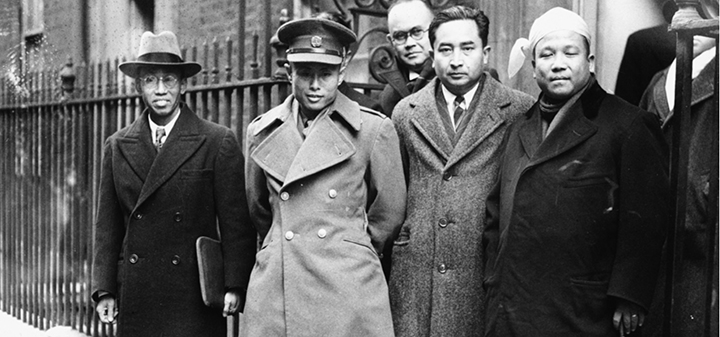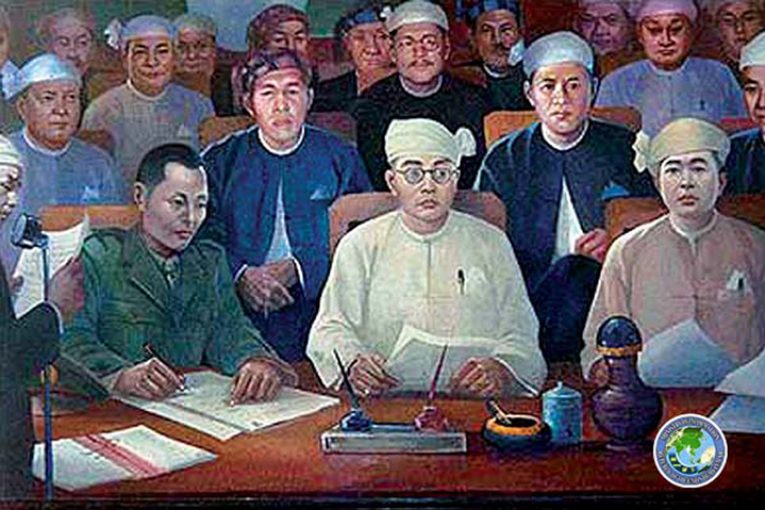The fourth White Paper
It had become inevitable for the colonialists to grant independence to Myanmar sooner or later when the World War II ended in 1945. The colonial government implemented the White Paper, which divided the plains and hill region in governing the country. So, General Aung San and leaders of frontier areas started making preparations to demand independence for the Myanmar proper and the hill regions as a whole.
The colonial government did the utmost to prevent Myanmar proper and hill regions from making political contacts and collaboration between them. The colonialists sow seeds of mistrust between ethnic Bamars and other ethnic races.
Unity and harmony
The meeting of the AFPFL headquarters that was held from 16 to 18 August 1945 adopted a unanimous decision to restore independence through the united involvement of all the national races of the whole nation. The decision was seconded at the Nay Thu Rein mass rally held on 19 August. All Myanmar Conference which was held at the third terrace of Shwedagon Pagoda on 20 January 1946 urged the minorities to take part in the independence struggle with might and main. The second AFPFL conference, held from 16 to 23 May 1946 made a resolution to oppose the White Paper that might torn the country apart. An announcement was issued on 31 December 1946 for all the hill regions to join the Union of their own volition.

Aung San-Atlee
The resolutions and demands of the mass rallies and leading body meetings were reflecting the national unity. The main goal was the establishment of the united and independent Union that is free from any discrimination between the states and the Myanmar proper. In accordance with the goal, General Aung San told Prime Minister Atlee at the London meeting that his aspiration was to reestablish the united Myanmar. He said, “In my view, there will be no difficulty in establishing a united nation if all the nationalities of the country are granted freedom and allowed to meet each other, without any eternal instigation.” Then the Panglong Agreement was signed. The Panglong Conference stated in the Agreement referred to the meeting hosted by the Shan Chieftains with the participation of Myanmar representatives and the representatives of the hill regions in the following month.
The First Panglong Conference
Visionary Shan chieftains made arrangements for hosting a conference between the leaders of hill regions and leaders of Myanmar proper at a certain venue in Shan State. So, the Panglong Conference was held in February 1947. Before the Panglong Conference, some Shan feudal lords and leaders were launching a movement against the merging of the Myanmar proper and hill regions. A meeting was held at a middle school in Nanphatka, a Kachin village, near Kutkai in northern Shan State to debate the issue of partition or integration. The British Parliamentary Secretary on Dominion Affairs arrived in Myanmar on 4 February 1947.
The Panglong Conference began on 3 February. Shan chieftains, who were the members of the Shan Chieftains Council, and people’s representatives held discussions on that day. On 5 February, Shan and Kachin representatives held an informal meeting. An announcement calling for holding a serious demonstration, expressing an ardent desire to restore independence together with the Myanmar proper, in all towns and territories was issued because of the prevalence of make-in-or-break-it situation. The announcement also pledged to drive out the colonialists together with the Myanmar proper and to restore independence in unity between the hill regions and Myanmar proper. On 6 February, Shan and Kachin representatives held a pre-Panglong meeting and laid down resolutions. Chin representatives arrived on that day. Chin representative studied the discussions between Shan and Kachin representatives, made some additions and signed an accord. Then a body on Hill Region Unity was formed. As the British government in Yangon rejected the desires of the chieftains and the people’s representatives at 5 pm, over 2000 people held a meeting at 9:30 pm. The decisions were made. The radio station in Yangon aired the event.

The root of Union Spirit
The Panglong Conference continued on 8 February. General Aung San and delegation and the British delegation arrived at Panglong. Soon after his arrive, General Aung San held talks with representatives of nationalities at 8 pm. A paper including demands under the name of Hill Regions Unity Council was presented the following day. General Aung San was so annoyed when he found that the demands were non-negotiable. When the Bamar leaders led by General Aung San were invited to attend the Panglong Conference, British officers in Shan State tried to block them from attending the conference. In spite of obstacles and disagreements, the First Panglong Conference established the Union Spirit in the hearts of the nation.
By Kaung Zan Thein
(Translated by TMT)



